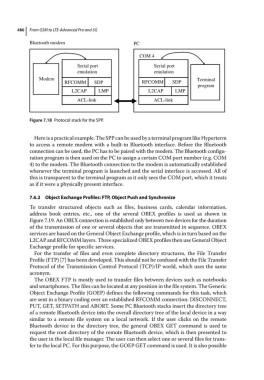Page 500 - From GMS to LTE
P. 500
486 From GSM to LTE-Advanced Pro and 5G
Bluetooth modem PC
COM 4
Serial port Serial port
emulation emulation
Modem Terminal
RFCOMM SDP RFCOMM SDP
program
L2CAP LMP L2CAP LMP
ACL-link ACL-link
Figure 7.18 Protocol stack for the SPP.
Here is a practical example. The SPP can be used by a terminal program like Hyperterm
to access a remote modem with a built‐in Bluetooth interface. Before the Bluetooth
connection can be used, the PC has to be paired with the modem. The Bluetooth configu-
ration program is then used on the PC to assign a certain COM port number (e.g. COM
4) to the modem. The Bluetooth connection to the modem is automatically established
whenever the terminal program is launched and the serial interface is accessed. All of
this is transparent to the terminal program as it only sees the COM port, which it treats
as if it were a physically present interface.
7.6.2 Object Exchange Profiles: FTP, Object Push and Synchronize
To transfer structured objects such as files, business cards, calendar information,
address book entries, etc., one of the several OBEX profiles is used as shown in
Figure 7.19. An OBEX connection is established only between two devices for the duration
of the transmission of one or several objects that are transmitted in sequence. OBEX
services are based on the General Object Exchange profile, which is in turn based on the
L2CAP and RFCOMM layers. Three specialized OBEX profiles then use General Object
Exchange profile for specific services.
For the transfer of files and even complete directory structures, the File Transfer
Profile (FTP) [7] has been developed. This should not be confused with the File Transfer
Protocol of the Transmission Control Protocol (TCP)/IP world, which uses the same
acronym.
The OBEX FTP is mostly used to transfer files between devices such as notebooks
and smartphones. The files can be located at any position in the file system. The Generic
Object Exchange Profile (GOEP) defines the following commands for this task, which
are sent in a binary coding over an established RFCOMM connection: DISCONNECT,
PUT, GET, SETPATH and ABORT. Some PC Bluetooth stacks insert the directory tree
of a remote Bluetooth device into the overall directory tree of the local device in a way
similar to a remote file system on a local network. If the user clicks on the remote
Bluetooth device in the directory tree, the general OBEX GET command is used to
request the root directory of the remote Bluetooth device, which is then presented to
the user in the local file manager. The user can then select one or several files for trans-
fer to the local PC. For this purpose, the GOEP GET command is used. It is also possible

